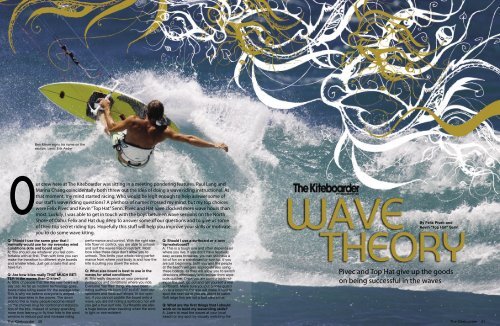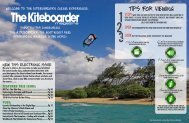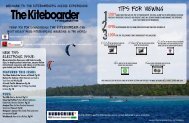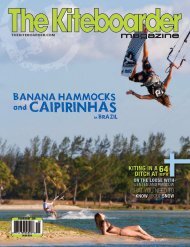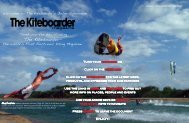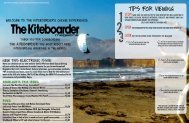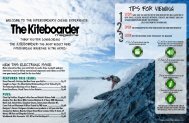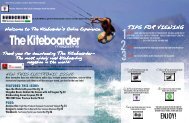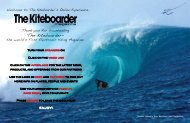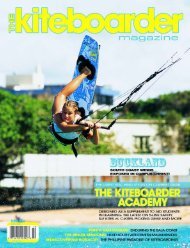Safety When Launching and Landing - The Kiteboarder Magazine
Safety When Launching and Landing - The Kiteboarder Magazine
Safety When Launching and Landing - The Kiteboarder Magazine
You also want an ePaper? Increase the reach of your titles
YUMPU automatically turns print PDFs into web optimized ePapers that Google loves.
Ben Meyer signs his name on the<br />
section. Lens: Erik Aeder<br />
our crew here at <strong>The</strong> <strong>Kiteboarder</strong> was sitting in a meeting pondering features. Paul Lang <strong>and</strong><br />
Marina Chang coincidentally both threw out the idea of doing a wave riding instructional. At<br />
that moment, my mind started racing. Who would be legit enough to help answer some of<br />
our staff’s wave riding questions? A plethora of names crossed my mind, but my top choices<br />
were Felix Pivec <strong>and</strong> Kevin “Top Hat” Senn. Pivec <strong>and</strong> Hat have clocked more wave hours than<br />
most. Luckily, I was able to get in touch with the boys between wave sessions on the North<br />
Shore of Oahu. Felix <strong>and</strong> Hat dug deep to answer some of our questions <strong>and</strong> to give us some<br />
of their top secret riding tips. Hopefully this stuff will help you improve your skills or motivate<br />
you to do some wave kiting.<br />
Q: Should I use the same gear that I<br />
normally would use for my everyday wind<br />
conditions (kite <strong>and</strong> board size)?<br />
A: You should use whatever you feel comfortable<br />
with at first. <strong>The</strong>n with time you can<br />
make the transition to different style boards<br />
<strong>and</strong> smaller kites. Just get a taste first <strong>and</strong><br />
have fun.<br />
Q: Are bow kites really THAT MUCH BET-<br />
TER in the waves than C-kites?<br />
A: 90% of people that like the new bows will<br />
say yes. As far as modern technology goes,<br />
bows make kiting easier for the average kiter.<br />
This is why we believe everyone is amped<br />
on the bow kites in the waves. <strong>The</strong> down<br />
side to this is many people become reliant<br />
on the chicken loop for control <strong>and</strong> stabilization<br />
of the kite, instead of simply spending<br />
more time learning to fly their kite in the wind<br />
window to reduce pull <strong>and</strong> increase riding<br />
performance <strong>and</strong> control. With the right size<br />
kite flown in control, you are able to unhook<br />
<strong>and</strong> surf the waves free of restraint. Most<br />
bow kites these days don’t allow you to<br />
unhook. This limits your whole riding performance<br />
from where your body is <strong>and</strong> how the<br />
kite is pulling you down the wave.<br />
Q: What size board is best to use in the<br />
waves for what conditions?<br />
A: This really depends on your personal<br />
preference <strong>and</strong> conditions where you ride.<br />
Everyone has their thing. We have been<br />
riding surfboards from 5’0’’ to 6’6’’ from our<br />
sponsors <strong>and</strong> local surf shops. In our opinion,<br />
if you cannot paddle the board onto a<br />
wave, you are not riding a surfboard nor will<br />
you get a true surf ride. Surfboards are also<br />
a huge bonus when traveling when the wind<br />
is light or non-existent.<br />
Q: Should I use a surfboard or a twin<br />
tip/wakeboard?<br />
A: This is a tough one <strong>and</strong> often depends on<br />
where you live. If you don’t have relatively<br />
easy access to waves, you can still have a<br />
lot of fun on a wakeboard or twin tip. If you<br />
are just beginning, both you <strong>and</strong> the people<br />
at the beach will also appreciate you using<br />
these boards, as they will allow you to switch<br />
directions effortlessly <strong>and</strong> recover from wipeouts<br />
quicker. Once you are comfortable riding<br />
in the surf, go out <strong>and</strong> get yourself a real<br />
surfboard. Make sure you put a nose guard<br />
on as a board in the eye will make it hard to<br />
spot the next wave you are about to catch.<br />
Soft edge fins are not a bad idea either.<br />
Q: What are the first things that I should<br />
work on to build my waveriding skills?<br />
A. Learn to read the waves at your local<br />
beach or any spot by visually watching the<br />
By Felix Pivec <strong>and</strong><br />
Kevin “Top Hat” Senn<br />
Pivec <strong>and</strong> Top Hat give up the goods<br />
on being successful in the waves<br />
<strong>The</strong> <strong>Kiteboarder</strong> 40 <strong>The</strong> <strong>Kiteboarder</strong> 41


